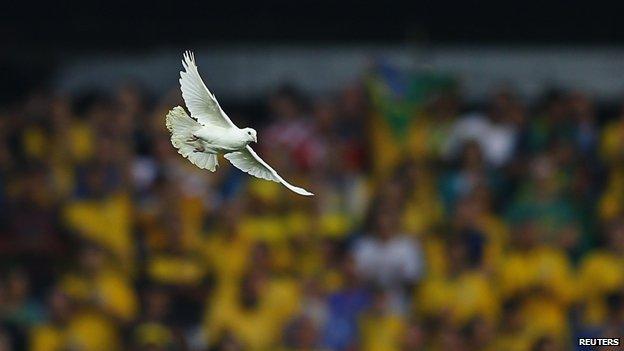Tweeting the World Cup
- Published
- comments

This has been the week the United States finally got football - or soccer, as they still insist on calling it.
As the USA team progressed to the knock-out stage, the story has led the breakfast TV shows and been the subject of a diatribe by right-wing columnist Ann Coulter, external, who sees US interest in the game as a sign of the nation's moral decay.
But let's not exaggerate. I was sitting in my San Francisco hotel room watching the crucial USA game with Germany, when I glanced out on the street. In England a similar game would have seen the world stand still for a couple of hours, but here most people were going about their business as normal and the traffic was no lighter than on any other morning. And afterwards I found myself explaining to puzzled Americans why they had progressed despite having lost to Germany.
One place however is completely absorbed in the World Cup. I popped into the headquarters of Twitter in downtown San Francisco and found vast screens in the company restaurant showing the games. Elsewhere, people sat in little cabins, also furnished with screens for the football.
Like other technology firms I've visited here, Twitter has a very international workforce, so many of the staff are following their home nation's progress. But for the company itself the World Cup is a huge event, and a key part of its strategy to build and engage its audience as questions mount about whether its growth has stalled. Anyone joining the service in recent weeks has been invited to "choose your side to unlock new custom World Cup features". There are hashtags galore, and flag symbols pop up in Tweets about your team.
Simon Rogers used to be the Guardian's data editor. He was appointed last year to do a similar job for Twitter. He's spending the World Cup diving into the vast pool of data generated by the event and trying to draw patterns.
He takes me through some of the key stats - 300 million tweets about the World Cup so far, external, twice as many as during the whole of the 2012 London Olympics. The own goal scored by Brazil's Marcelo in the opening game was the most tweeted moment to date with 12.2 million tweets. Lionel Messi and Brazil's Neymar are the most mentioned players so far - though Luis Suarez roared up into third place after his recent biting incident.
Twitter's world cup
What's really striking is just how many of the players are now engaging with their fans via Twitter, with the majority signed up and tweeting. The prize for the most retweeted player goes to Italy's Mario Balotelli whose cheeky message, external about getting a kiss from the Queen, got 177,000 retweets.
Simon Rogers shows me the global nature of the Twitter World Cup experience by playing me a data visualisation of the USA v Portugal game. Tweets exploded out of the US and Portugal as goals were scored but there were also points of light from Latin America to Asia - the world is using Twitter to engage with each game and to join in a global conversation.
What this does for Twitter as a business is more obscure. Yes, some of the big World Cup sponsors are paying for promoted tweets during the tournament but we will have to wait for the next set of financial results to see if there has been the big growth in advertising revenue that Twitter now needs to show its investors.
They have been worried that the social media platform is just a bit too complex, a bit too niche to engage the kind of audience that is needed to justify its sky-high valuation. If Twitter can keep on board those who've come to laugh and celebrate and rage about each dramatic moment, then it will truly be a World Cup winner.